Belgian Land Component
| Land Component Composante terre / Landcomponent Landkomponente | |
|---|---|
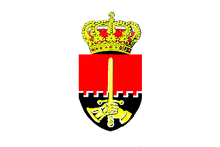 The flag of the Belgian army since 1982. | |
| Active |
1830–2002 (as the Belgian Army) 2002–present (as the Belgian Land Component) |
| Country |
|
| Allegiance |
|
| Type | Army |
| Size | 12,000 military personnel and 2,000 civilian personnel |
| Part of |
|
| Commanders | |
| Commander | Major-General Jean-Paul Deconinck |
The Land Component (Dutch: Landcomponent, French: Composante terre) is the land-based branch of the Belgian Armed Forces. The current chief of staff of the Land Component is Major-General Jean-Paul Deconinck.
For a detailed history of the Belgian Army from 1830 to post 1945 see Belgian Armed Forces.
Ranks in use by the Belgian Army are listed at Belgian military ranks.
Organisation 1870s


According to the Law of 16 August 1873, the army was to consist of:
Infantry
- 14 regiments of line infantry (three active battalions, one inactive and one company in each regiment depot)
- 3 regiments of Jäger (three active battalions, one inactive and one company in each regiment depot)
- 1 regiment of grenadiers (three active battalions, one inactive and one company in each regiment depot)
- 1 regiment of Carabinier (four battalions active, 2 inactive and 1 depot company of deposit)
- 2 companies settled
- 1 discipline body
- 1 school of children troop
Note: a battalion (864 men) consists of four companies of 216 men
Cavalry
- 4 regiments of lancers (4 active squadrons and one reinforcement in each regiment)
- 2 regiments of guides (ditto)
- 2 regiments of Chasseur (ditto)
Note: a squadron had approximately 130 horses
Artillery
- 4 regiments of artillery (10 batteries in each regiment)
- 3 regiments of fortress artillery or siege artillery (16 batteries, 1 battery and 1 spare battery depot in each regiment)
- 1 pontoon company
- 1 company of artificers
- 1 company of gunsmiths
- 1 company of artillery workers
Note: A battery has 6 guns
Engineering
- 1 Engineer Regiment (3 active battalions and one depot battalion)
- 1 railway company
- 1 campaign Telegraph company
- 1 telegraph room company
- 1 pontoon room company
- 1 workers company
Train
- 7 train companies
World War I
See Belgian Army order of battle (1914) A major reorganisation of the army had been authorised by the government in 1912, providing for a total army of 350,000 men by 1926 - 150,000 in the field forces, 130,000 in fortress garrisons and 70,000 reserves and auxiliaries. At the outbreak of war this reorganisation was nowhere near complete and only 117,000 men could be mobilised for the field forces, with the other branches equally deficient.
The Commander-in-Chief was King Albert I, with Lieutenant-General Chevalier de Selliers de Moranville as the Chief of the General Staff.
- 1st Division (Lieutenant-General Baix) - around Ghent.
- 2nd Division (Lieutenant-General Dassin) - Antwerp.
- 3rd Division (Lieutenant-General Leman) - around Liège.
- 4th Division (Lieutenant-General Michel) - Namur and Charleroi.
- 5th Division (Lieutenant-General Ruwet) - around Mons.
- 6th Division (Lieutenant-General Albert Lantonnois van Rode) - Brussels.
- Cavalry Division (Lieutenant-General de Witte) - Brussels.
In addition, there were garrisons at Antwerp, Liège and Namur, each placed under the command of the local divisional commander.[1]
Each division contained three mixed brigades (of two infantry regiments and one artillery regiment), one cavalry regiment, and one artillery regiment, as well as various support units. Each infantry regiment contained three battalions, with one regiment in each brigade having a machine-gun company of six guns. An artillery regiment had three batteries of four guns.
The nominal strength of a division varied from 25,500 to 32,000 all ranks, with a total strength of eighteen infantry battalions, a cavalry regiment, eighteen machine-guns, and forty-eight guns. Two divisions (the 2nd and 6th) each had an additional artillery regiment, for a total of sixty guns.
The Cavalry Division had two brigades of two regiments each, three horse artillery batteries, and a cyclist battalion, along with support units; it had a total strength of 4,500 all ranks with 12 guns, and was - in effect - little more than a reinforced brigade.
The Belgian Army stubbornly resisted during the early days of the war, with the army - around a tenth the size of the German Army - holding up the German offensive for nearly a month, giving their French and British allies time to strengthen for the Marne counteroffensive later in the year.
World War II
In 1940, the King of Belgium was the commander in chief of the Belgian Army which had 100,000 active duty personnel; its strength could be raised to 550,000 when fully mobilized. The army was composed of seven infantry corps, that were garrisoned at Brussels, Antwerp, and Liege, and two divisions of partially-mechanised cavalry Corps at Brussels and the Ardenne. The Corps were as follows:
- I Corps with the 1st, 4th, and 7th Infantry Divisions
- II Corps with the 6th, 11th, and 14th Infantry Divisions
- III Corps with the 1st Chasseurs Ardennais and the 2nd and 3rd Infantry Divisions
- IV Corps with the 9th, 15th, and 18th Infantry Divisions
- V Corps with three divisions
- VI Corps with three divisions
Each Army Corps had its own headquarters staff, two active and several reserve Infantry Divisions, Corps Artillery Regiment of four battalions of two batteries with 16 artillery pieces per battalion, and a Pioneer regiment.
Each infantry divisions had a divisional staff along with three infantry regiments, each of 3,000 men. Each regiment had 108 light machine guns, 52 heavy machine guns, nine heavy mortars or infantry gun howitzers, plus six antitank guns.
Within the Free Belgian Forces that were formed in Great Britain during the occupation of Belgium between 1940–45, there was a land force formation, the 1st Belgian Infantry Brigade. An additional three divisions were raised and trained in Northern Ireland, but the war ended before they could see action. However, they joined the initial Belgian occupation force in Germany, I Belgian Corps, whose headquarters moved to Luedenscheid in October 1946.[2] Of the 75,000 troops that found themselves in Germany on 8 May 1945, the vast majority had been recruited after the liberation of Belgium.[3]
Cold War
During the Cold War, Belgium provided the I Belgian Corps (HQ Haelen Kaserne, Junkersdorf, Lindenthal (Cologne)), consisting of the 1st Infantry Division in Liège and 16th Mechanised Division in Neheim-Hüsten, to NATO's Northern Army Group for the defence of West Germany.[4] There were also two reserve brigades (10th Mechanised Brigade, Limbourg, and the 12th Motorised Brigade, Liège), slightly bigger than the four active brigades, which were intended as reinforcements for the two divisions. Interior forces comprised the Para-Commando Regiment in Heverlee, three national defence light infantry battalions (5th Chasseurs Ardennais, 3rd Carabiniers-cyclistes, and 4th Carabiniers-cyclistes), four engineer battalions and nine provincial regiments with two to five light infantry battalions each. (Isby and Kamps, 1985, 64, 72)
After the end of the Cold War, forces were reduced. Initial planning in 1991 called for a Belgian-led corps with 2 or 4 Belgian brigades, a German brigade, and possibly a U.S. brigade.[5] However, by 1992 this plan was looking unlikely and in 1993 a single Belgian division with two brigades became part of the Eurocorps.[6]
Structure

The Land Component is organised using the concept of capacities, whereby units are gathered together according to their function and material. Within this framework, there are five capacities: command, combat, support, services and training.
The command capacity groups the following levels of command: COMOPSLAND (Operational Command of the Land Component), Medium Brigade at Leopoldsburg (formed from the 1st Mechanised Brigade in 2011) and Light Brigade (formerly the 7th Mechanised Brigade) at Marche-en-Famenne.
The combat capacity comprises the main fighting units of the Land Component. It consists of two Para-Commando battalions, the Special Forces Group and five infantry battalions. The support capacity comprises one reconnaissance battalion, a civilian-military cooperation and operational communication battalion, one artillery battalion and two engineer battalions.
The service capacity comprises three communication and information systems (CIS) groups, three logistics battalions, the Military Police Group and the Military Detachment at the Palace of the Nation, the Explosive Ordnance Disposal (known as DOVO in Dutch and SEDEE in French, the Movement Control Group and the training centres and camps.
The training capacity comprises four departments: the Training Department Infantry at Arlon, the Training Department Armour-Cavalry at Leopoldsburg, the Training Department Artillery at Brasschaat and the Training Department Engineers at Namur.
Some of the regiments in the Land Component, such as the Regiment 12th of the Line Prince Leopold - 13th of the Line, have names consisting of multiple elements. This is the result of a series of amalgamations which took place over the years. The Regiment 12th of the Line Prince Leopold - 13th of the Line was created in 1993 as a result of the merger of the 12th Regiment of the Line Prince Leopold and the 13th Regiment of the Line.
Equipment
Firearms
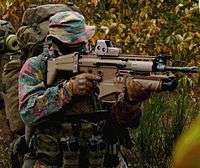
| Weapon | Caliber | Origin | Notes |
|---|---|---|---|
| Pistols | |||
| Browning GP | 9×19mm | Standard issue firearm, being phased out in favour of the FN Five-seven. | |
| FN Five-seven | 5.7×28 mm | Formerly issued to pilots and SFG members, now entering service as the standard issue sidearm. | |
| Submachine Guns | |||
| FN Uzi | 9×19mm | Made under license by FN Herstal, used as a personal defence weapon for Special Forces,Navy and Medical personnel. | |
| FN P90 | 5.7×28 mm | Personal defence weapon used by selected troops, including special forces. | |
| Assault Rifles, Battle Rifles and Carbines | |||
| FN FNC | 5.56×45mm | Service rifle, To be replaced with SCAR-L. | |
| FN F2000 | 5.56×45mm | Used by special forces, and elsewhere in limited quantities to serve alongside the FN FNC. | |
| FN SCAR-L | 5.56×45mm | 4500 SCAR-L ordered to replace the FNC as the new standard service rifle between 2015-2017. | |
| FN SCAR-H | 7.62×51mm | 63 SCAR-H CQC ordered for special forces combat divers. | |
| Sniper Rifles | |||
| FN SCAR-H PR | 7.62×51mm | 287 SCAR-H PR rifles on order to replace the AW between 2015 - 2017 | |
| Accuracy International Arctic Warfare | 7.62×51mm | Will be replaced by a combination of SCAR-H PR, AXMC and M107A1. | |
| Accuracy International AX338 | .338 LM | ||
| Barrett M107A1 | 12.7×99mm | 59 delivered by the end of 2014 | |
| Machine Guns | |||
| FN Minimi 5.56 Mk3 Tactical SB | 5.56×45mm | Standard issue LMG. Currently being updated to 'Mk3 Tactical SB' standards.
Featuring a shorter barrel, Adjustable buttstock with shoulder rest, Ergonomic railed handguard, new bipod assembly and cocking handle. | |
| FN Minimi 7.62 Mk3 | 7.62×51mm | The Belgian government signed a 2 million euro contract to replace all MAG's with 242 Minimi's chambered in 7.62x51mm. | |
| FN MAG | 7.62×51mm | Standard general-purpose machine gun. To be replaced with 242 7.62x51mm chambered Minimi's. | |
| M2HB | 12.7×99 mm | Standard Issue HMG | |
| Shotguns | |||
| Remington 870 | 12-gauge | In service since 2008[7] | |
| Grenade Launchers | |||
| GL-1 | 40×46mm | Used by regular infantry and paratroopers mounted under FN F2000 rifles on a squad based level. | |
| FN40GL | 40×46mm | Used by special forces mounted under FN SCAR rifles | |
| Heckler & Koch GMG | 40×53mm | Mounted on the army's new Jankel FOX Rapid Reaction Vehicles. | |
| Anti-tank Missile Launchers | |||
| MILAN | 115 mm | Will be replaced by Spike ATGM in the near future. | |
| Spike-MR | 152 mm | 66 new anti-tank missile systems are currently being deliverd to replace the army's older MILAN ATGM. [8] | |
| Anti-tank Rocket Launchers | |||
| M72 LAW | 66 mm | Will be replaced by panzerfaust 3 as the short range anti-tank weapon on a squad based level. | |
| Panzerfaust 3 | 110 mm | 111 short range anti-tank weapons are to be purchased in the near future.[8] | |
| Anti-air Missile Launchers | |||
| MISTRAL | Infrared surface-to-air missile. 30 in service[9] | ||
| Artillery | |||
| 120 RT Mortar | 120 mm | About 30 in use[9] | |
| M1 Mortar | 81 mm | About 42 in use[9] | |
| M19 Mortar | 60 mm | About 60 used by the ParaCommando regiment for light fire support.[9] | |
| LG1 Mark II Howitzer | 105 mm | About 24 in use[9] | |
| Grenades | |||
| Mecar M72 HE grenade | NA | Fragmentation hand grenade | |
| Mecar M93BG grenade | NA | Rifle grenade for the FN FNC | |
| M18 grenade | NA | Smoke hand grenade | |
| Mines | |||
| M6A2 Mine | NA | Anti-tank mine | |
| Miscellaneous | |||
| HAFLA | NA | Single-shot, disposable incendiary weapon | |
Vehicles
The Belgian Army is currently undergoing a major re-equipment programme for most of its vehicles. The aim is to phase out all tracked vehicles in favour of wheeled vehicles. As of 2010, the tank units were to be disbanded or amalgamated with the Armored Infantry (two infantry companies and one tank squadron per battalion). 40 Leopard 1 tanks were still waiting to be sold; the rest were transferred to Lebanon. As of 2013, only some M113 variants (Radar, recovery, command posts and driving school vehicles) and Leopard variants (Recovery, AVLB, Pionier, driving tanks) will remain in service.
The Leopard 1A5 tank was retired on 10 September 2014. 56 of the tanks will be sold, about 24 will stay as historic monuments or serve as a museum pieces; the rest will be phased out or used for target practice.[10][11]
| Name | Origin | Type | Number | Photo | Notes | |
|---|---|---|---|---|---|---|
| Armoured vehicles | ||||||
| Piranha IIIC | |
Armoured fighting vehicle | 268 | |
| |
| Pandur I | |
Armoured personnel carrier | 59[12] | 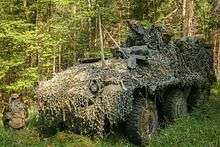 |
| |
| ATF Dingo 2 MPPV | |
Infantry mobility vehicle | 218[12] | _21.jpg) |
| |
| Iveco LMV | |
Infantry mobility vehicle | 439 | 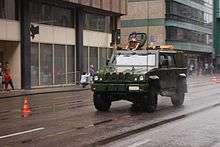 |
||
| Jankel FOX | Light Rapid Response Vehicle | 108 | _14.jpg) |
The FOX of the original is Toyota Land Cruiser, contract for the Belgian Armed forces includes a removable armour kit to increase ballistic and mine protection. The vehicles will be fitted with a 360° ring mount which can be armed with a 12.7mm machine gun or an automatic grenade launcher. | ||
| Unarmoured vehicles | ||||||
| Unimog 1.9T | Light Truck | 61 |  |
| ||
| Iveco M250 | |
Medium Heavy Truck | 400 |
_26.jpg) |
350 with optional removable ballistic protection kits | |
| Iveco ALC 8x4 | Autonomous Load Carrier | 149 | |
In service since 2004 | ||
| Mercedes-Benz Actros | Transport Truck | 60 | |
In service since 2002 | ||
| Renault Kerax | Tow Truck | 27 | In service since 2001 | |||
| Scania T144 | Heavy Transport | 26 | In service since 2002 | |||
| Groundhog | Terrain Vehicle | 38 | In service since 2009 | |||
| M-Gator | |
Light utility vehicle | Used for medical evacuation | |||
Former Equipment
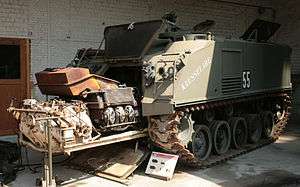
- MAP - NATO :
- Armor
- AIFVs
 M75
M75 AMX-VCI
AMX-VCI CVR(T)
CVR(T) AIFV
AIFV M113 including indigenous variants
M113 including indigenous variants Various types of M3 Half-track
Various types of M3 Half-track
- SP artillery
- Others
Future
In the stratregical defence vision report of the Belgian government it was stated that by 2030 the Belgian land component will invest in new modern equipment such as weapons, vehicles, communication assets, body armor and more.
Notes
- ↑ George Nafziger's order of battle for the Belgian Army in 1914 can be seen at http://usacac.army.mil/cac2/CGSC/CARL/nafziger/914WAAA.pdf
- ↑ Isby and Kamps, 1985, 59
- ↑ Entre rEssEntimEnt et ré-éducation: L’Armée belge d’Occupation et les Allemands, 1945-1952, accessed August 2014.
- ↑ Steven J. Zaloga, Tank War: Central Front NATO vs Warsaw Pact, Osprey Elite 26, 1989, p.25. See also (Fr) Les Forces Belges en Allemagne, accessed April 2009
- ↑ "Cold War Battle Orders Make Way for a New NATO Era", Jane's Defence Weekly, June 8, 1991, p. 961.
- ↑ Decision Soon on Division, JANE'S DEFENCE WEEKLY, 20-Mar-1993, and Belgian Division Joins Eurocorps, Jane's Defence Weekly, 23 October 1993
- ↑ "Belgian Defence Remington 870 fact sheet". Retrieved 14 January 2015.
- 1 2 Belgium selects Spike missile to replace Milan - Armyrecognition.com, January 3, 2013
- 1 2 3 4 5 "Belgian Defense Information". European Defense Information. Armed Forces.co.uk. Retrieved 22 April 2014.
- ↑ http://www.mil.be/nl/artikel/leopard-lost-zijn-laatste-schot
- ↑ http://www.demorgen.be/dm/nl/989/Binnenland/article/detail/1978837/2014/08/02/Belgie-verkoopt-56-Leopardtanks.dhtml
- 1 2 http://www.mil.be/nl/material-type/voertuigen
External links
| Wikimedia Commons has media related to Army of Belgium. |
- Belgian Army website (in French)
- Belgian Army website (in Dutch)
- http://www.sfg.be - The Special Forces Group of the belgian army
